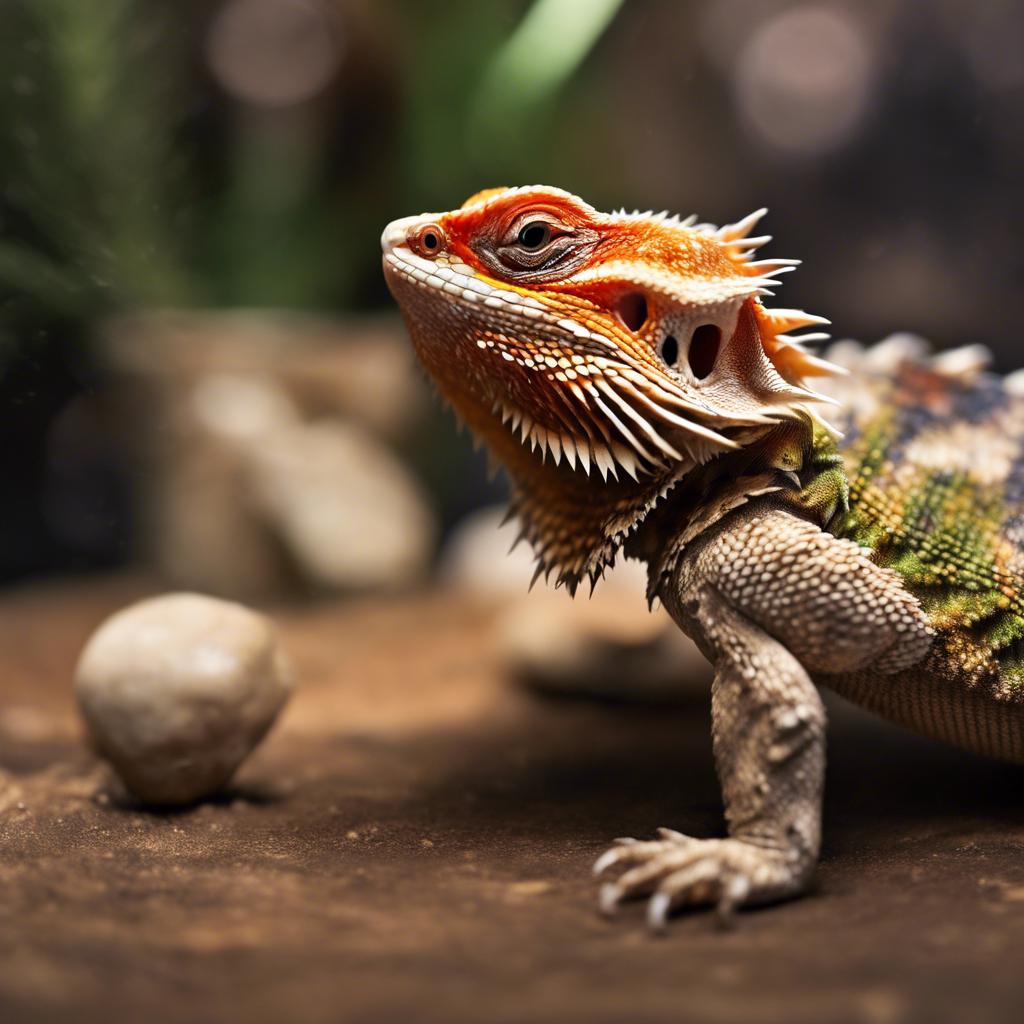Bearded dragons, scientifically known as Pogona, are a type of lizard native to Australia. They are popular pets due to their docile nature, unique appearance, and relatively low maintenance requirements. Bearded dragons are medium-sized reptiles, typically growing to about 18-24 inches in length. They have a triangular-shaped head with rows of spiky scales that resemble a beard, which they can puff out when threatened or displaying dominance.
One of the reasons why bearded dragons make great pets is their calm and friendly demeanor. They are known for being relatively easy to handle and can become quite tame with regular interaction. Bearded dragons are also highly adaptable and can thrive in a variety of environments, making them suitable for both beginner and experienced reptile owners.
Key Takeaways
- Bearded dragons are popular pets that require proper care and attention.
- Understanding their behavior and body language can help prevent scratching and other issues.
- Providing a spacious tank with proper lighting, temperature, and humidity is crucial for their health.
- A balanced diet and hydration are important for their nutrition and overall well-being.
- Regular check-ups and proper handling can prevent common health issues and ensure a happy and healthy pet.
Understanding Bearded Dragon Behavior
To properly care for a bearded dragon, it is important to understand their normal behaviors and what they mean. Bearded dragons are diurnal creatures, meaning they are most active during the day and sleep at night. They are also territorial animals and may display dominance behaviors such as head bobbing or arm waving.
Signs of stress or illness in bearded dragons include loss of appetite, lethargy, weight loss, changes in behavior or appearance, and respiratory issues. It is important to monitor your bearded dragon closely and seek veterinary care if you notice any concerning symptoms.
Reasons for Bearded Dragon Scratching
Bearded dragons may scratch themselves for various reasons. One common reason is shedding their skin. Like all reptiles, bearded dragons periodically shed their skin as they grow. During this process, they may scratch or rub against objects to help remove the old skin.
Another reason for scratching could be due to dry skin or irritation. Bearded dragons require proper hydration and humidity levels to maintain healthy skin. If the enclosure is too dry or the humidity levels are too low, it can lead to dry skin and itching.
To address and prevent scratching behaviors, it is important to provide a suitable environment for your bearded dragon. This includes maintaining proper humidity levels, providing a proper diet, and ensuring they have access to a clean and spacious enclosure.
Importance of Proper Tank Size and Setup
Bearded dragons require a spacious enclosure to thrive. The minimum tank size for an adult bearded dragon is 40 gallons, but larger tanks are recommended to provide more room for exercise and exploration. A tank with dimensions of at least 36 inches long, 18 inches wide, and 18 inches tall is ideal.
In addition to the tank size, the setup of the enclosure is also important. Bearded dragons need a basking area with a heat lamp to maintain their body temperature, as well as a cooler area for them to retreat to. The enclosure should also include hiding spots, branches or logs for climbing, and a shallow water dish for drinking and soaking.
Providing Adequate Lighting and Temperature
Proper lighting and temperature are crucial for the health and well-being of bearded dragons. They require both UVB lighting and heat lamps to mimic their natural habitat in Australia.
UVB lighting is essential for bearded dragons as it helps them produce vitamin D3, which is necessary for calcium absorption. Without adequate UVB lighting, bearded dragons can develop metabolic bone disease, which can lead to weak bones and other health issues. It is recommended to use a UVB bulb specifically designed for reptiles and replace it every 6-12 months.
In terms of temperature, bearded dragons require a basking spot with a temperature range of 95-105°F (35-40°C) during the day. The cooler side of the enclosure should have a temperature range of 75-85°F (24-29°C). It is important to monitor the temperatures regularly and adjust the heat lamps or heating elements accordingly.
Hydration and Humidity Needs of Bearded Dragons

Proper hydration and humidity levels are essential for the health of bearded dragons. They require access to fresh water at all times, which should be provided in a shallow dish that they can easily drink from and soak in. Bearded dragons may also benefit from occasional misting to help maintain proper hydration.
Humidity levels in the enclosure should be kept between 30-40%. Too much humidity can lead to respiratory issues, while too little humidity can cause dry skin and shedding problems. It is important to monitor the humidity levels using a hygrometer and make adjustments as needed by adding or removing moisture from the enclosure.
Feeding and Nutrition for Bearded Dragons
Bearded dragons are omnivorous reptiles, meaning they eat both plant matter and insects. A balanced diet for a bearded dragon consists of leafy greens, vegetables, fruits, and insects. Leafy greens such as collard greens, mustard greens, and dandelion greens should make up the majority of their diet.
Vegetables such as squash, bell peppers, and carrots can also be offered in moderation. Fruits should be given sparingly due to their high sugar content. Insects such as crickets, mealworms, and dubia roaches can be offered as a source of protein.
It is important to provide a varied diet to ensure that your bearded dragon receives all the necessary nutrients. Calcium and vitamin supplements may also be necessary to prevent deficiencies. Feeding should occur once or twice a day for juveniles and every other day for adults.
Common Health Issues and How to Prevent Them
Bearded dragons are generally hardy reptiles, but they can still experience health issues if not properly cared for. Some common health issues in bearded dragons include metabolic bone disease, respiratory infections, parasites, and impaction.
To prevent these health issues, it is important to provide a proper diet, maintain proper temperatures and humidity levels, and keep the enclosure clean. Regular veterinary check-ups are also recommended to catch any potential health issues early on.
Handling and Interacting with Bearded Dragons
Proper handling and interaction are important for bonding with your bearded dragon and ensuring their well-being. When handling a bearded dragon, it is important to support their body and avoid squeezing or applying pressure to their abdomen. They should be handled gently and with care to avoid causing stress or injury.
Bearded dragons can be socialized through regular handling and interaction. Spending time with your bearded dragon outside of their enclosure can help them become more comfortable with you and their surroundings. It is important to create a calm and quiet environment during handling to minimize stress.
Caring for Your Bearded Dragon and Addressing Scratching Behaviors
In conclusion, bearded dragons make great pets due to their friendly nature and relatively low maintenance requirements. To properly care for a bearded dragon, it is important to understand their behavior, provide a suitable environment, maintain proper lighting and temperature, ensure proper hydration and humidity levels, provide a balanced diet, prevent common health issues, and handle them properly.
Addressing scratching behaviors in bearded dragons involves providing a suitable environment with proper humidity levels, ensuring they have access to fresh water for hydration, and addressing any underlying health issues that may be causing the scratching. By following these care tips and addressing scratching behaviors promptly, you can provide a happy and healthy life for your bearded dragon.
If you're concerned about your bearded dragon scratching at its tank, it's important to understand the possible reasons behind this behavior. One article on Reptile Wizard's website explores the topic of bearded dragons and stress, discussing whether these reptiles can die from stress. Understanding the potential impact of stress on your pet's health can help you address any issues that may be causing them to scratch at their tank. To learn more about this topic, check out the article “Can Bearded Dragons Die from Stress?“
FAQs
What is a bearded dragon?
A bearded dragon is a type of lizard that is native to Australia. They are popular pets due to their docile nature and ease of care.
Why is my bearded dragon scratching at its tank?
There are several reasons why a bearded dragon may be scratching at its tank. It could be a sign of boredom, stress, or a desire for more space. It could also be a sign of a health issue, such as parasites or skin irritation.
How can I tell if my bearded dragon is stressed?
Signs of stress in bearded dragons include scratching at the tank, loss of appetite, lethargy, and changes in behavior or appearance. If you suspect your bearded dragon is stressed, it is important to address the issue promptly to prevent further health problems.
What can I do to prevent my bearded dragon from scratching at its tank?
Providing your bearded dragon with adequate space, enrichment, and a healthy diet can help prevent boredom and stress. Regular veterinary check-ups can also help identify and address any health issues that may be causing the scratching behavior.
Is scratching at the tank harmful to my bearded dragon?
Scratching at the tank itself is not harmful to the bearded dragon, but it may be a sign of an underlying issue that needs to be addressed. Ignoring the behavior could lead to further health problems or stress for the animal.

